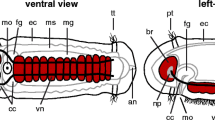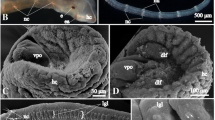Abstract
We have analyzed brain structure in Macrostomum lignano, a representative of the basal platyhelminth taxon Macrostomida. Using confocal microscopy and digital 3D modeling software on specimens labeled with general markers for neurons (tyrTub), muscles (phalloidin), and nuclei (Sytox), an atlas and digital model of the juvenile Macrostomum brain was generated. The brain forms a ganglion with a central neuropile surrounded by a cortex of neuronal cell bodies. The neuropile contains a stereotypical array of compact axon bundles, as well as branched terminal axons and dendrites. Muscle fibers penetrate the flatworm brain horizontally and vertically at invariant positions. Beside the invariant pattern of neurite bundles, these “cerebral muscles” represent a convenient system of landmarks that help define discrete compartments in the juvenile brain. Commissural axon bundles define a dorsal and ventro-medial neuropile compartment, respectively. Longitudinal axons that enter the neuropile through an invariant set of anterior and posterior nerve roots define a ventro-basal and a central medial compartment in the neuropile. Flanking these “fibrous” compartments are neuropile domains that lack thick axon bundles and are composed of short collaterals and terminal arborizations of neurites. Two populations of neurons, visualized by antibodies against FMRFamide and serotonin, respectively, were mapped relative to compartment boundaries. This study will aid in the documentation and interpretation of patterns of gene expression, as well as functional studies, in the developing Macrostomum brain.






Similar content being viewed by others
References
Ashburner M (1989) Drosophila, a laboratory manual. Cold Springs Harbor Laboratory, New York
Ax P (1996) Multicellular animals: a new approach to the phylogenetic order in nature. Springer, Berlin Heidelberg New York
Baguñà J, Riutort M (2004) The dawn of bilaterian animals: the case of acoelomorph flatworms. BioEssays 26:1046–1057
Bedini C, Lanfranchi A (1991) The central and peripheral nervous system of Acoela (Plathelminthes)—an electron-microscopic study. Acta Zool 72:101–106
Bedini C, Lanfranchi A (1998) Ultrastructural study of the brain of a typhloplanid flatworm. Acta Zool 79:243–249
Biserova NM, Dudicheva VA, Terenina NB, Reuter M, Halton DW, Maule AG, Gustafsson MK (2000) The nervous system of Amphilina foliacea (Platyhelminthes, Amphilinidea). an immunocytochemical, ultrastructural and spectrofluorometrical study. Parasitology 121:441–453
Bueno D, Baguna J, Romero R (1997) Cell-, tissue-, and position-specific monoclonal antibodies against the planarian Dugesia (Girardia) tigrina. Histochem Cell Biol 107:139–149
Bullock TH, Horridge GA (1965) Structure and function in the nervous system of invertebrates. Two volumes. Freeman, San Francisco, CA
Cardona A, Hartenstein V, Romero R (2005) The embryonic development of the triclad Schmidtea polychroa. Dev Genes Evol 215:109–131
Cardona A, Hartenstein V, Romero R (2006) Early embryogenesis of planaria: a cryptic larva feeding on maternal resources. Dev Genes Evol 216:667–681
Cebria F, Nakazawa M, Mineta K, Ikeo K, Gojobori T, Agata K (2002) Dissecting planarian central nervous system regeneration by the expression of neural-specific genes. Dev Growth Differ 44:135–146
Chien P, Koopowitz H (1972) The ultrastructure of neuromuscular systems in Notoplana acticola,a free-living polyclad flatworm. Z Zellforsch 133:277–288
Cornell RA, Ohlen TV (2000) Vnd/nkx, ind/gsh, and msh/msx: conserved regulators of dorsoventral neural patterning? Curr Opin Neurobiol 10:63–71
Cousin CE, Dorsey CH (1991) Nervous system of Schistosoma mansoni cercaria: organization and fine structure. Parasitol Res 77:132–141
Egger B, Ladurner P, Nimeth K, Gschwentner R, Rieger R (2006) The regeneration capacity of the flatworm Macrostomum lignano-on repeated regeneration, rejuvenation, and the minimal size needed for regeneration. Dev Genes Evol 216:565–577
Ehlers U (1985) Das phylogenetische System der Plathelminthes. Fischer, Jena
Elvin M, Koopowitz H (1994) Neuroanatomy of the rhabdocoel flatworm Mesostoma ehrenbergii (Focke, 1836). I. Neuronal diversity in the brain. J Comp Neurol 343:319–331
Gustafsson MK, Halton DW, Kreshchenko ND, Movsessian SO, Raikova OI, Reuter M, Terenina NB (2002) Neuropeptides in flatworms. Peptides 23:2053–2061
Halton DW, Shaw C, Maule AG, Johnston CF, Fairweather I (1992) Peptidergic messengers: a new perspective of the nervous system of parasitic platyhelminths. J Parasitol 78:179–193
Hanstroem B (1968) Vergleichende Anatomie des Nervensystems der Wirbellosen Tiere. A. Asher, Amsterdam
Hartenstein V, Ehlers U (2000) The embryonic development of the rhabdocoel flatworm Mesostoma lingua. Dev Genes Evol 210:399–415
Holland ND (2003) Early central nervous system evolution: an era of skin brains? Nat Rev Neurosci 4:617–627
Joffe B, Reuter M (1993) The nervous system of Bothriomolud balticus (Proseriata)—a contribution to the knowledge of the orthogon in Plathelminthes. Zoomorphology 113:113–127
Keenan CL, Coss R, Koopowitz H (1981) Cytoarchitecture of primitive brains: Golgi studies in flatworms. J Comp Neurol 195:697–716
Klauser MD, Tyler S (1987) Frontal glands and sensory structures in the Macrostomida (Turbellaria). Zool Scr 16:95–110
Koopowitz H (1986) On the evolution of central nervous systems: Implications from polyclad turbellarian neurobiology. Hydrobiologia 132:79–87
Koopowitz H, Elvin M, Keenan L (1996) In vivo visualization of living flatworm neurons using Lucifer yellow intracellular injections. J Neurosci Methods 69:83–89
Ladurner P, Mair GR, Reiter D, Salvenmoser W, Rieger R (1997) Serotonergic nervous system of two macrostomid species: recent or ancient divergence. Invertebr Biol 116:178–191
Ladurner P, Pfister D, Seifarth C, Scharer L, Mahlknecht M, Salvenmoser W, Gerth R, Marx F, Rieger R (2005a) Production and characterisation of cell- and tissue-specific monoclonal antibodies for the flatworm Macrostomum sp. Histochem Cell Biol 123:89–104
Ladurner P, Schärer L, Salvenmoser W, Rieger R (2005b) A new model organism among the lower Bilateria and the use of digital microscopy in taxonomy of meiobenthic Platyhelminthes: Macrostomum lignano, n. sp. (Rhabditophora, Macrostomorpha). J Zoolog Syst Evol Res 43:114–126
Lentz TL (1967) Fine structure of nerve cells in a planarian. J Morphol 121:323–337
Lichtneckert R, Reichert H (2005) Insights into the urbilaterian brain: conserved genetic patterning mechanisms in insect and vertebrate brain development. Heredity 94:465–477
Lowe CJ, Terasaki M, Wu M, Freeman RM Jr, Runft L, Kwan K, Haigo S, Aronowicz J, Lander E, Gruber C, Smith M, Kirschner M, Gerhart J (2006) Dorsoventral patterning in hemichordates: insights into early chordate evolution. PLoS Biol 4:e291
Morris J, Nallur R, Ladurner P, Egger B, Rieger R, Hartenstein V (2004) The embryonic development of the flatworm Macrostomum sp. Dev Genes Evol 214:220–239
Morris J, Ladurner P, Rieger R, Pfister D, De Miguel-Bonet M, Jacobs D, Hartenstein V (2006) The Macrostomum lignano EST database as a molecular resource for studying platyhelminth development and phylogeny. Dev Genes Evol 216:695–707
Okamoto K, Takeuchi K, Agata K (2005) Neural projections in planarian brain revealed by fluorescent dye tracing. Zoolog Sci 22:535–546
Pereanu W, Hartenstein V (2004) Digital three-dimensional models of Drosophila development. Curr Opin Genet Dev 14:382–391
Pereanu W, Hartenstein V (2006) Neural lineages of the Drosophila brain: a three-dimensional digital atlas of the pattern of lineage location and projection at the late larval stage. J Neurosci 26:5534–5553
Radojcic T, Pentreath VW (1979) Invertebrate glia. Prog Neurobiol 12:115–179
Ramachandra NB, Gates R, Ladurner P, Jacobs D, Hartenstein V (2002) Neurogenesis in the primitive bilaterian Neochildia I. Normal development and isolation of genes controlling neural fate. Dev Genes Evol 212:55–69
Reddien PW, Bermange AL, Murfitt KJ, Jennings JR, Sanchez Alvarado A (2005) Identification of genes needed for regeneration, stem cell function, and tissue homeostasis by systematic gene perturbation in planaria. Dev Cell 8:635–649
Reiter D, Boyer B, Ladurner P, Mair G, Salvenmoser W, Rieger R (1996) Differentiation of the bodywall musculature in Macrostomum hystrinicum marinum and Hoploplana inquilina (Plathelminthes), as models for muscle development in lower spiralia. Roux’s Arch Dev Biol 205:410–423
Reuter M, Gustafsson MKS (1995) The flatworm nervous system: pattern and phylogeny. In: Breidbach O, Kutsch W (eds) The nervous system of invertebrates. Birkhäuser Verlag Basel
Reuter M, Raikova OI, Jondelius U, Gustafsson MKS, Maule AG, Halton DW (2001) Organisation of the nervous system in the Acoela: an immunocytochemical study. Tissue Cell 33:119–128
Rieger R (1971) Die Turbellarienfamilie Dolichmacrostomidae Rieger. II. Teil: Dolichomacrostominae. Zool Jahrb Syst 98:569–703
Rieger RM, Tyler S, Smith JPS III, Rieger GE (1991) Platyhelminthes: turbellarida. In: Harrison FW, Bogitsh BJ (eds) Microscopic anatomy of invertebrates, vol.3. Wiley-Liss, New York
Rieger RM, Salvenmoser W, Legniti A, Tyler S (1994) Phalloidin-rhodamine preparations of Macrostomum hystrinicum marinum (Plathelminthes)-morphology and postembryonic development of the musculature. Zoomorphology 114:133–147
Sanchez Alvarado A, Newmark PA, Robb SM, Juste R (2002) The Schmidtea mediterranea database as a molecular resource for studying Platyhelminthes, stem cells and regeneration. Development 129:5659–5665
Shaw MK (1981) The ultrastructure of synapses in the brain of Gastrocotyle trachuri (Monogenea, Platyhelminthes). Cell Tissue Res 220:181–189
Shaw C, Maule AG, Halton DW (1996) Platyhelminth FMRFamide-related peptides. Int J Parasitol 26:335–345
Sopott-Ehlers B, Salvenmoser W, Reiter D, Rieger R, Ehlers U (2001) Photoreceptors in species of the Macrostomida (Plathelminthes): ultrastructural findings and phylogenetic implications. Zoomorphology 121:1–12
Strausfeld NJ (1976) Atlas of an insect brain. Springer, Berlin Heidelberg New York
Telford MJ, Wise MJ, Gowri-Shankar V (2005) Consideration of RNA secondary structure significantly improves likelihood-based estimates of phylogeny: Examples from the Bilateria. Mol Biol Evol 22:1129–1136
Thomas MB (1986) Embryology of the turbellaria and its phylogenetic significance. Hydrobiologia 132:105–115
Xylander WER, Rohde K, Watson NA (1997) Ultrastructural investigations of the sensory receptors of Macrostomum cf bulbostylum (Plathelminthes, Macrostomida). Zool Anz 236:1–12
Younossi-Hartenstein A, Hartenstein V (2000a) The embryonic development of the polyclad flatworm Imgogine mcgrathi. Dev Genes Evol 210:383–398
Younossi-Hartenstein A, Hartenstein V (2000b) Comparative approach to developmental analysis: the case of the dalyellid flatworm, Gieysztoria superba. Int J Dev Biol 44:499–506
Younossi-Hartenstein A, Hartenstein V (2001) The embryonic development of the temnocephalid flatworms Craspedella pedum and Diceratocephala sp. Cell Tissue Res 304:295–310
Younossi-Hartenstein A, Ehlers U, Hartenstein V (2000) Embryonic development of the nervous system of the rhabdocoel flatworm Mesostoma lingua (Abildgaard, 1789). J Comp Neurol 416:461–476
Younossi-Hartenstein A, Jones M, Hartenstein V (2001) The embryonic development of the nervous system of the temnocephalid flatworm Craspedella pedum. J Comp Neurol 434:56–68
Younossi-Hartenstein A, Salvaterra P, Hartenstein V (2003) Early development of the Drosophila brain IV. Larval neuropile compartments defined by glial septa. J Comp Neurol 45:435–450
Younossi-Hartenstein A, Nguyen B, Shy D, Hartenstein V (2006) Embryonic origin of the Drosophila brain neuropile. J Comp Neurol 497:981–998
Acknowledgements
This work was supported by NSF Grant IBN-0110718 to V.H. and the Graduate Student Training Fellowship GM0718 to J.M.
Author information
Authors and Affiliations
Corresponding author
Additional information
Communicated by D.A. Weisblat
Rights and permissions
About this article
Cite this article
Morris, J., Cardona, A., De Miguel-Bonet, M.D.M. et al. Neurobiology of the basal platyhelminth Macrostomum lignano: map and digital 3D model of the juvenile brain neuropile. Dev Genes Evol 217, 569–584 (2007). https://doi.org/10.1007/s00427-007-0166-z
Received:
Accepted:
Published:
Issue Date:
DOI: https://doi.org/10.1007/s00427-007-0166-z




